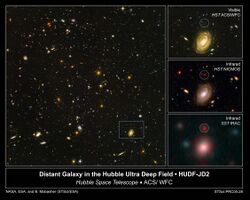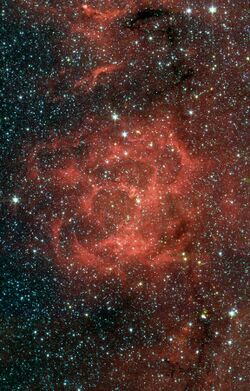Astronomy:Infrared Array Camera


The Infrared Array Camera (IRAC) was an infrared camera system on the Spitzer Space Telescope which operated in the mid-infrared spectrum.[1] It was composed of four detectors that operated simultaneously at different wavelengths; all four were in use until 2009 May 15 when the Spitzer cryostat ran out of liquid helium.[2] After then, the spacecraft operated in a warm extended mission, in which two of the four detectors remained functional, until the Spitzer mission was terminated on 2020 January 30.[2]
During its primary mission, IRAC was able to simultaneously operate in four wavelengths: 3.6 μm, 4.5 μm, 5.8 μm, and 8.0 μm.[1][3] Each infrared detector had dimensions of 256×256 pixels—a significant improvement over previous spaceborne infrared telescopes—and each image taken covered 5.12 square arcminutes of sky with each pixel covering 1.2 arcseconds.[1][4] The detectors operating at 3.6 μm and 4.5 μm were constructed with indium antimonide (InSb), while the 5.8 μm and 8.0 μm detectors were made of silicon doped with arsenic (Si:As).[1][3][5] The telescope's primary and secondary mirrors, along with its supporting structure, were made mostly of beryllium.[4] The telescope was cryogenically cooled to around 2 K (−271 °C; −456 °F); the 3.6 μm and 4.5 μm detectors operated at 15 K (−258 °C; −433 °F) and the 5.8 μm and 8.0 μm detectors operated at 6 K (−267 °C; −449 °F).[6]
After Spitzer's liquid helium coolant ran out on 2009 May 15, the spacecraft warmed up over several months.[7] IRAC stabilized at its warm mission operating temperature of 28.7 K (−244 °C; −408 °F) on 2009 September 18.[7] This meant that the 5.8 μm and 8.0 μm detectors could not function as they required the cryogenic cooling,[1] but the 3.6 μm and 4.5 μm detectors remained about as sensitive as they were during the primary mission.[8] The other two Spitzer instruments (IRS and MIPS) likewise ceased to function as they worked at longer wavelengths, leaving IRAC as the sole operational instrument.[8]
The cryogenic assembly of IRAC is contained in the Multiple Instrument Chamber (MIC), which also houses the other focal plane elements and the pointing calibration reference sensor. In the MIC is the Infrared Array Camera, Infrared Spectrograph, and Multiband Imaging Photometer, as well as the pointing calibration reference sensor.[9] The MIC is attached to the cryostat and was intended to keep the science instruments, including IRAC, cold but also functioned to keep out stray light.[9] The MIC is mounted to the helium chamber inside the cryostat vacuum shell, not only to efficiently keep the instruments cold but to seal out any stray light.[9] The IRAC warm electronics assembly is housed in the spacecraft bus.[6] The IRAC instrument was built by the Goddard Space Flight Center and the detectors were built by Raytheon. Its operational and scientific management is handled by the Smithsonian Astrophysical Observatory.[6]
Bands summary
IRAC was capable of observing in the wavelengths of 3.6, 4.5, 5.8, and 8.0 microns. When its coolant ran out, only the two shorter wavelengths remained usable.[1][3]
See also
- MIRI (Mid-Infrared Instrument)
- NIRCam, a James Webb Space Telescope instrument for 0.6 to 5 μm light
References
- ↑ Jump up to: 1.0 1.1 1.2 1.3 1.4 1.5 "The Infrared Array Camera (IRAC)". NASA / JPL / Caltech. http://www.spitzer.caltech.edu/mission/398-The-Infrared-Array-Camera-IRAC-. Retrieved 13 January 2017.
- ↑ Jump up to: 2.0 2.1 Szondy, David (28 August 2016). "Spitzer goes "Beyond" for final mission". New Atlas. http://newatlas.com/spitzer-beyond/45123/. Retrieved 13 January 2017.
- ↑ Jump up to: 3.0 3.1 3.2 Fazio, G. G. et al. (September 2004). "The Infrared Array Camera (IRAC) for the Spitzer Space Telescope". The Astrophysical Journal Supplement Series 154 (1): 10–17. doi:10.1086/422843. Bibcode: 2004ApJS..154...10F.
- ↑ Jump up to: 4.0 4.1 "Infrared Detector Developments". NASA / JPL / Caltech. http://www.spitzer.caltech.edu/mission/192-Infrared-Detector-Developments. Retrieved 13 January 2017.
- ↑ "IRAC Instrument Handbook: Appendix E. Acronyms". NASA/IPAC Infrared Science Archive. NASA / JPL / Caltech. http://irsa.ipac.caltech.edu/data/SPITZER/docs/irac/iracinstrumenthandbook/93/. Retrieved 13 January 2017.
- ↑ Jump up to: 6.0 6.1 6.2 Gehrz, R. D. et al. (January 2007). "The NASA Spitzer Space Telescope". Review of Scientific Instruments 78 (1): 011302. doi:10.1063/1.2431313. PMID 17503900. Bibcode: 2007RScI...78a1302G. https://authors.library.caltech.edu/7348/1/GEHrsi07.pdf.
- ↑ Jump up to: 7.0 7.1 "Warm IRAC Image Characteristics". NASA/IPAC Infrared Science Archive. NASA / JPL / Caltech. http://irsa.ipac.caltech.edu/data/SPITZER/docs/irac/warmimgcharacteristics/. Retrieved 13 January 2017.
- ↑ Jump up to: 8.0 8.1 Hora, Joseph L. et al. (September 2012). Clampin, Mark C; Fazio, Giovanni G; MacEwen, Howard A et al.. eds. "The IRAC point response function in the warm Spitzer mission". Proceedings of the SPIE. Space Telescopes and Instrumentation 2012: Optical, Infrared, and Millimeter Wave. Space Telescopes and Instrumentation 2012: Optical, Infrared, and Millimeter Wave 8442: 844239. doi:10.1117/12.926894. Bibcode: 2012SPIE.8442E..39H. https://authors.library.caltech.edu/99024/1/844239.pdf.
- ↑ Jump up to: 9.0 9.1 9.2 "The Multiple Instrument Chamber". NASA / JPL / Caltech. http://www.spitzer.caltech.edu/mission/182-The-Multiple-Instrument-Chamber. Retrieved 13 January 2017.
External links
- IRAC website by the Harvard–Smithsonian Center for Astrophysics
- Spitzer Documentation & Tools: IRAC by the Infrared Science Archive
 |


